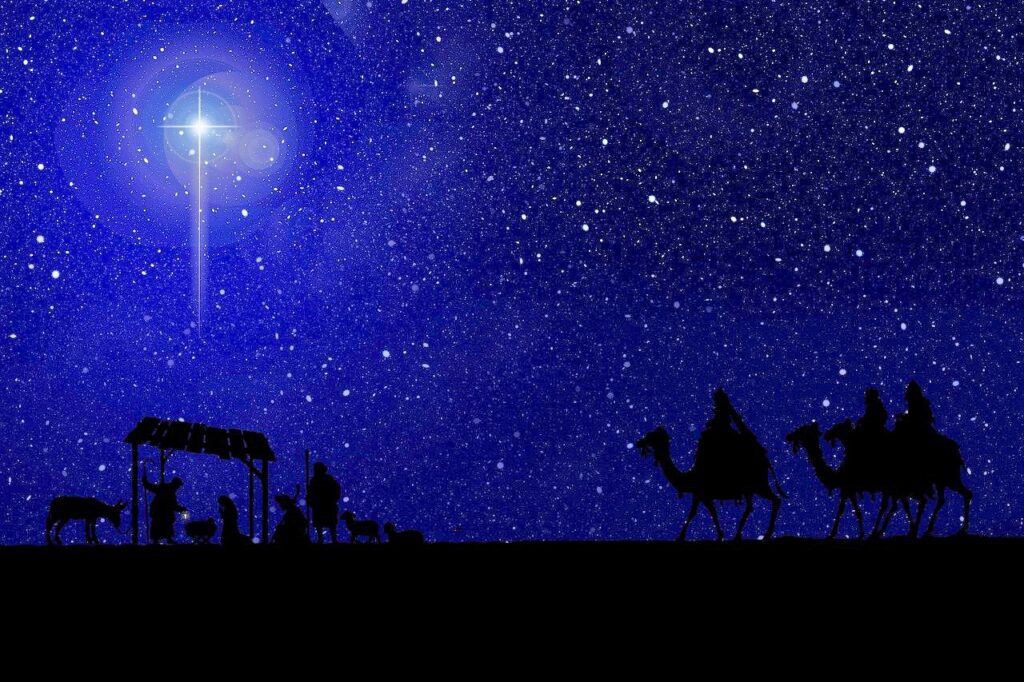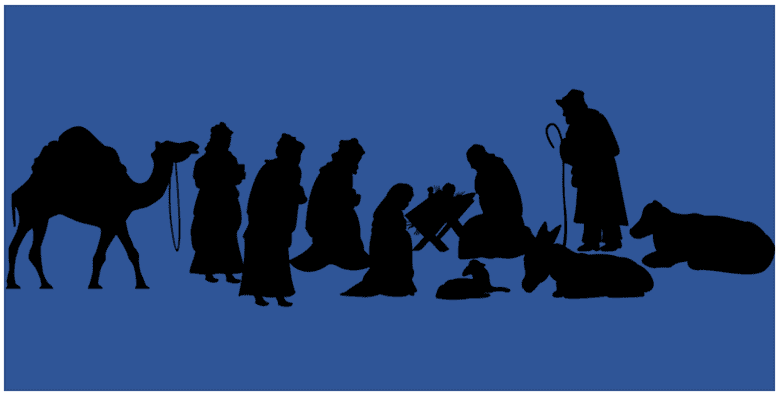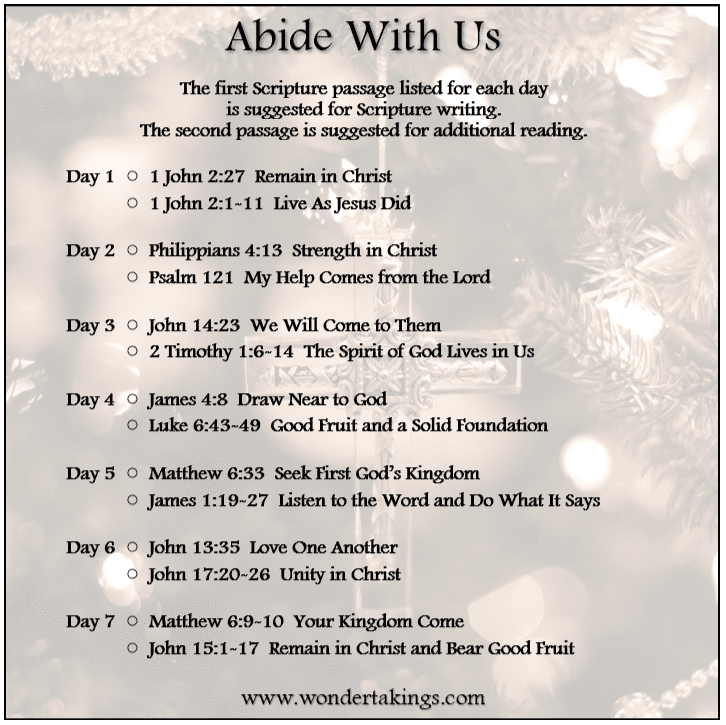Abide With Us
“But when the right time finally came, God sent his own Son. He came as the son of a human mother and lived under the Jewish Law, to redeem those who were under the Law, so that we might become God’s children.”
Galatians 4:4-5 GNT

God chose “the right time” to send His Son into the world. Why then? Why not earlier or later? Only God knows. His timing is always perfect, and He knew the right time to send Christ into the world.
“Men have been tempted to doubt God’s choice in history. The prophets were ready for the Messiah long before he came. And in our day some have felt that the present would have been better than 4 B. C. for a Savior to appear. . . . But God who could see the whole stream of human history knew best when to enter it.”
W. A. Poovey, Signs of His Coming
W. A. Poovey explains that the conditions were favorable for the spread of the gospel when Jesus was born. There was a common government and a common language. There were roads that made travel easier. And people at that time were searching for a better understanding of God. There may also have been other factors which caused God to choose that particular time in history. We don’t know. But God determined it was the right time.
“After Jesus was born in Bethlehem in Judea, during the time of King Herod, Magi from the east came to Jerusalem and asked, ‘Where is the one who has been born king of the Jews? We saw his star when it rose and have come to worship him.'”
Matthew 2:1-2 NIV

I read an old sermon by Paul L. Maier that talks about the magi. They were scholars, probably from Persia, whose expertise would have included astronomy and religion. According to the account in Matthew, a star led them to Jesus. We had an opportunity to see this “Christmas Star” again a few nights ago. The “star” was actually what’s known as a “great conjunction” of the planets Jupiter and Saturn, a rare event that occurs when the planets appear to line up in the night sky as they pass by earth. We had such a conjunction on the night of Dec. 21, 2020, nearly 800 years since the last one. It was cloudy that night where I live, but I was able to get a glimpse. Even through the clouds, it was really bright. But how did such a phenomenon lead the magi to Bethlehem? Paul L. Maier explains:
“In 7 B.C., about two years before the birth of Christ, magi all over the Middle East witnessed something spectacular in the skies — a phenomenon so rare that it happens only once in eight centuries. The planets Jupiter and Saturn came into extraordinary, repeated conjunction in that sign of the zodiac called Pisces, the Fishes. In the astrological lore, which all magi knew, Jupiter was deemed the king’s planet, and it symbolized the ruler of the universe, while Saturn was regarded as the shield or defender of Palestine, which was also associated with the constellation of the Fishes. The stars’ message, then, was clear: a king or cosmic ruler was about to visit Palestine. And if the Magi of the Christmas story were also acquainted with Hebrew lore, as many certainly were because of the Jewish colony in Babylon, they would have known that a star was expected to herald the birth of the Messiah (Numbers 24:17). . . . So when the Magi inquired of King Herod, ‘Where is he who has been born king of the Jews?’ their question was not really spoken out of a vacuum, and the story of their visit is not so fanciful after all.”
Paul L. Maier, “The Kings of Christmas”
So the magi didn’t really “follow” the star in the sense that they used it as a guide to find their way to Bethlehem. But it’s appearance did lead them to Jesus. This is a really interesting story, but why was it included in Matthew’s gospel? What purpose do the magi serve? Paul L. Maier gives the answer:
“A very simple but profound one, for the Wise Men brought more than gifts of gold and incense and perfume: they delivered, at Bethlehem, the charter for the universality of your Christian faith. The Magi were pagans, not Hebrews, and the fact that gentile sages performed the same adoration as Jewish shepherds symbolized the universal outreach for future Christianity. ‘And gentiles shall come to your light,’ the book of Isaiah had foretold, ‘and kings to the brightness of your rising.’ (60:3). And so Epiphany has well been called ‘The Gentiles’ Christmas.’ . . . The scene of proud and richly costumed Magi worshiping a baby in the humblest of circumstances has etched itself on the world’s imagination. And history’s most famous Christmas gifts, which they presented, are usually interpreted symbolically: gold signified Jesus’ kingship; frankincense denoted his future priesthood; and myrrh, an orange-colored aromatic resin, would be buried with him some 36 years later . . . .”
Paul L. Maier, “The Kings of Christmas”

The magi saw the “star” and it led them to Jesus, the “king of the Jews.” Jesus was not a king in the way that everyone expected. Jesus Himself said, “My kingdom is not of this world” (John 18:36 NIV). Christ’s kingdom is a spiritual one. He came to rule our hearts and minds. He came to give us citizenship in the kingdom of God. The magi’s visit shows that Jesus is not just the “king of the Jews” but the king of the world. When the magi found Jesus, they bowed down in worship and presented Him with precious gifts. Let’s follow their example. Let’s seek Him in order to worship Him. Let’s bow down and humble ourselves before Him. Let’s offer Him the gift of ourselves in honor of who He is.
“So then, my friends, because of God’s great mercy to us I appeal to you: Offer yourselves as a living sacrifice to God, dedicated to his service and pleasing to him. This is the true worship that you should offer.”
Romans 12:1 GNT

Jesus entered this world at “the right time,” but the Christmas story is more than a history lesson. As we begin to take down Christmas decorations and pack away our nativity sets, let’s remember that we, too, are active members in this ongoing story. Let the shepherds remind us to worship our Lord, let the wise men remind us to offer gifts to our King, let Mary and Joseph remind us to let love fill our hearts, and let the baby Jesus remind us of God’s great love for us. Let’s remember that while the right time for Jesus to enter our world was centuries ago, the right time for Jesus to enter our hearts is now.
“What happened at Bethlehem is more than an event; it is a pattern for life. God said at Christmas that the way to win men is through love, sacrifice and giving. And this is a pattern that must be constantly repeated. . . . the method chosen by God is the right one. Love is the answer, and only love will really change men and enable them to live together in peace. Sometimes love seems as strange an idea as the sending of a baby in a manger to lift men out of their sin. Nevertheless love works. It breaks the hardest heart and redirects the most stubborn individual. It is the key, the solution to life on this earth.”
W. A. Poovey, Signs of His Coming
God sent His Son because of His great love for us, and He wants us to share His love with the world. As we begin to look forward to the new year, let’s remember to let the love of Jesus live in our hearts. How exactly do we do this? I think C. S. Lewis explains it very well:
“The rule for all of us is perfectly simple. Do not waste time bothering whether you ‘love’ your neighbour; act as if you did. As soon as we do this we find one of the great secrets. When you are behaving as if you loved someone, you will presently come to love him. . . . whenever we do good to another self, just because it is a self, made (like us) by God, and desiring its own happiness as we desire ours, we shall have learned to love it a little more or, at least, to dislike it less. . . . Good and evil both increase at compound interest. That is why the little decisions you and I make every day are of such infinite importance. The smallest good act today is the capture of a strategic point from which, a few months later, you may be able to go on to victories you never dreamed of. . . . “
C. S. Lewis, Mere Christianity
“A new command I give you: Love one another. As I have loved you, so you must love one another.”
John 13:34 NIV

“We are always reluctant to come to the end of the Christmas season. We pack away the Christmas ornaments with a touch of sadness. ‘Another Christmas come and gone,’ we say. Yet one of our Christmas hymns tells us how the spirit of Christmas can be kept alive.
W. A. Poovey, Signs of His Coming
O Holy Child of Bethlehem,
Descend to us, we pray;
Cast out our sin, and enter in,
Be born in us today.
We hear the Christmas angels
The great glad tidings tell;
O come to us, abide with us,
Our Lord Immanuel.”
Abide with us. When we ask Jesus to enter our hearts, we ask Him to abide with us — remain in us — and transform us into images of Him. We ask Him to cleanse us of our sin and guilt to make room for His love, His peace, and His joy. When we do this, when we abide in Him and let Him abide in us, He will be able to use us to share His love, His peace, and His joy with others. It may be another 800 years before the world can see another Christmas star, but we can shine the light of Jesus to the world every day.
“Whoever says he abides in him ought to walk in the same way in which he walked.”
1 John 2:6 ESV
This week’s Scripture passages remind us to remain in Christ and let Him remain in us. There is a printer-friendly pdf version below the image. I have also included a video of “O Little Town of Bethlehem.” As we enter the new year, let’s ask Christ to enter our hearts: “O come to us, abide with us, our Lord Immanuel.”

“Let the peace of Christ rule in your hearts . . . .”
Colossians 3:15 NIV

References:
- Lewis, C. S. “Mere Christianity.” The Complete C. S. Lewis Signature Classics, Harper San Francisco, 2002, pp. 1-177.
- Maier, Paul L. “The Kings of Christmas.” A Child Is Born: Messages for Advent, Christmas, Epiphany, edited by John McCollister, Augsburg Publishing House, 1972, pp. 82-93.
- “O Little Town of Bethlehem – Norton Hall Band.” YouTube, uploaded by Southern Seminary, 30 November 2020, www.youtube.com/watch?v=pD8C7pzZ5Ts.
- Poovey, W. A. Signs of His Coming: Dramas & Meditations for Advent, Christmas, Epiphany. Augsburg Publishing House, 1973.
Images:
- Cross Ornament featured image by Julie Rothe from Pixabay
- Mary and Joseph image by enriquelopezgarre from Pixabay
- Christmas Star image by mskathrynne from Pixabay
- Wise Men image by Oberholster Venita from Pixabay
- Nativity Silhouette image by Bev from Pixabay
- Heart Ornament image by jhenning from Pixabay
- Peace Ornament image by t emmons from Pixabay